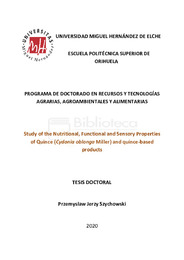Resumen :
Quinces are attracting interest due to their health promoting properties. In this thesis research started with quality parameters, bioactive compounds, antioxidant activity and the main sensory parameters determined in six Spanish quince clones. Quinces are high in phytic, malic and quinic acids, as well as in fructose, sorbitol and glucose, giving them an intriguing balance between sourness, astringency and sweetness. Total polyphenol content (TPC) and total antioxidant activity (TAA) were found to be significantly higher in quince peel than in pulp in both hydrophilic (H-TAA) and lipophilic (L-TAA) extracts; for example, the TPCpeel / TPCpulp ratio was equal to 4.7. The predominant fatty acids were linoleic (54.7%) and oleic (35.5%) acids, which reflected in a ratio of ~9–10 unsaturated to saturated fatty acids. The studied parameters were finally used to establish appropriate applications for quinces: (i) PUM fruits are better suited for preparation of functional quince-based products because of their high TPC and TAA (e.g. 5810 mg gallic acid kg−1peel and 5430 mg Trolox kg−1peel), while (ii) other clones, such as OHM14, ZM6 and OHM13, are appropriate for fresh consumption because of their equilibrated levels of sourness and sweetness and their high quince flavor.
Next step of this research was to find and analyze quince based processed product. Phytochemical profiles of 24 quince liquors have been analyzed as technological variant combinations. Liquors were obtained after macerating quinces from three varieties (Vranja, ALM3 and ZM2), with or without skin, at two ratios of quince:ethanol (50:50 and 25:75), and at two alcohol content (60% and 30%). Polyphenols were identified by LC-PDA-QTOF/MS and quantified by UPLC-PDA and UPLC-FL. A total of 18 polyphenolic compounds were identified and classified as 5 flavan-3-ols, 5 phenolic acids, and 8 flavonols. Flavan-3-ols were the most abundant group followed by hydroxycinnamates and flavonols. The highest contents of total polyphenols (1000 mg/100 mL) and antioxidant activity (37.1 mmol Trolox/100 mL) were found in the liquors prepared using fruits with skin and 50:50 quince:ethanol ratio. Quinces skin was the main source of phenolic acids, and especially flavonols. Quince liquor's high antioxidant activity and polyphenolic content may be considered as a promising new alcoholic beverage.
Final step of this research was to find best drying preservation method. Drying kinetics, bioactive compounds, antioxidant activity, and the main sensory parameters were determined in dried quinces, cultivar Leskovač, as affected by the drying method. The highest total polyphenols content was observed in dried samples obtained after freeze drying and convective drying at 50 °C. The best treatment for drying was vacuum-microwave drying at 480 W, considering only sensory attributes, because it led to intermediate dark color and high intensities of basic tastes and key flavor attributes. Ultimately, the parameters analyzed were used to suggest convective drying at 60 ° C as the most appropriate drying method for quinces, because it had a high content of total phenolic compounds (2nd best treatment out of 10), a good sensory profile, was inexpensive, and had no negative effects on nutritional or sensory parameters; the only downside was its long drying time.
|
 La licencia se describe como: Atribución-NonComercial-NoDerivada 4.0 Internacional.
La licencia se describe como: Atribución-NonComercial-NoDerivada 4.0 Internacional.
.png)
